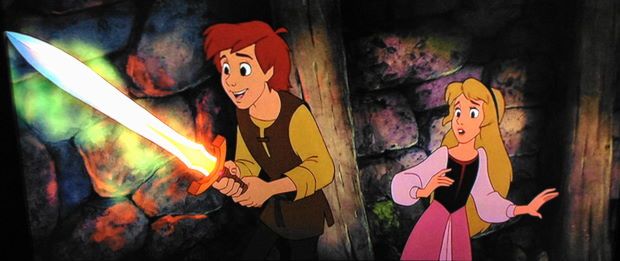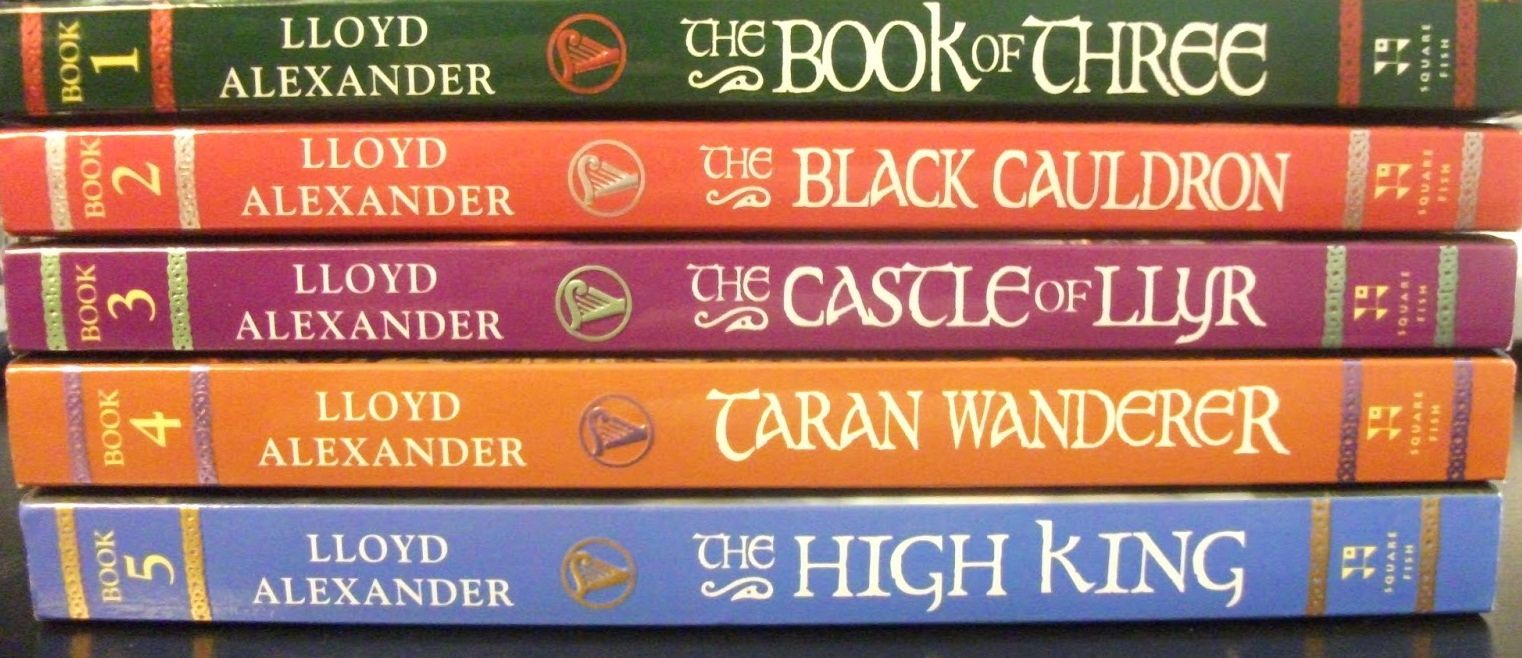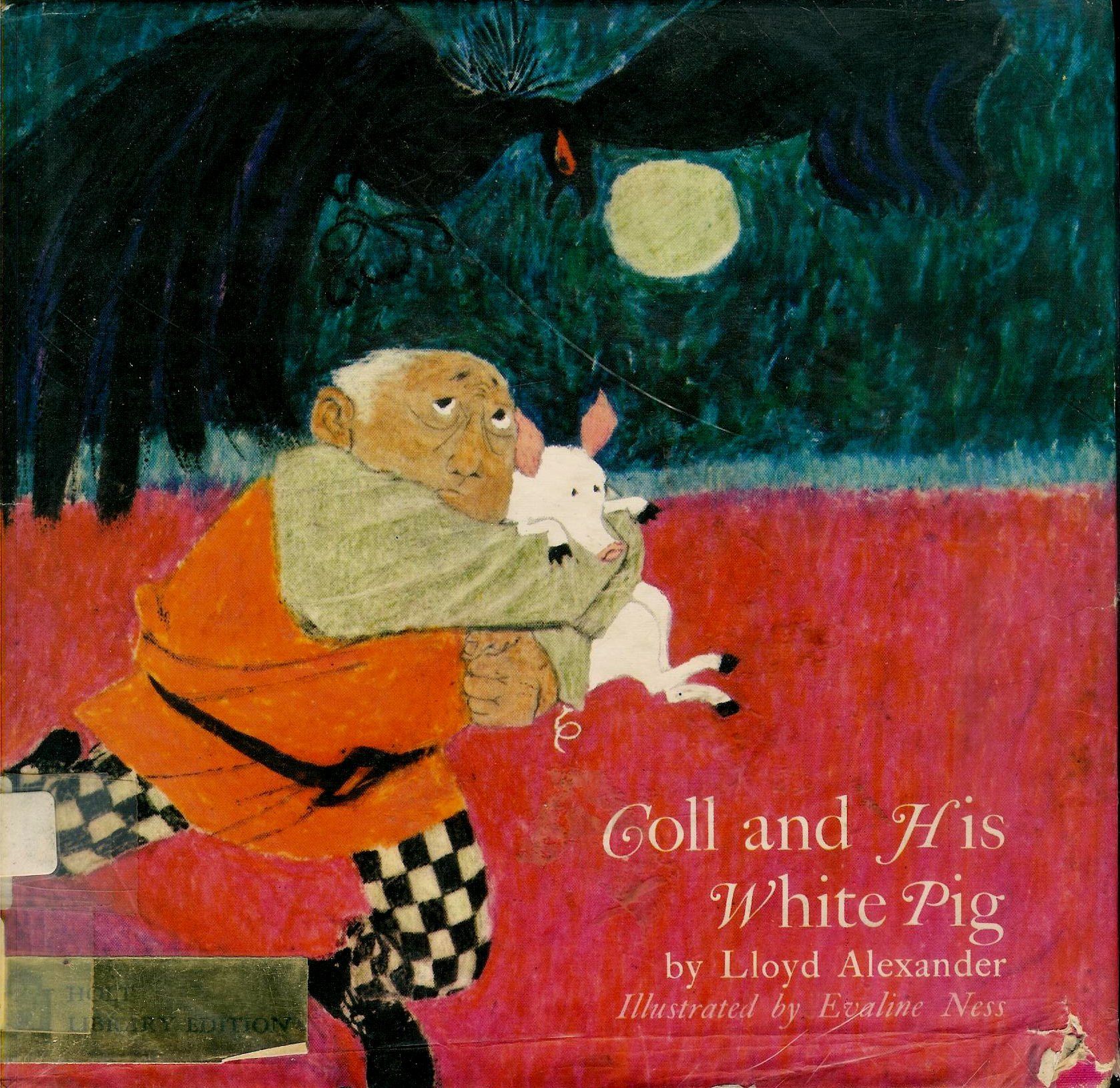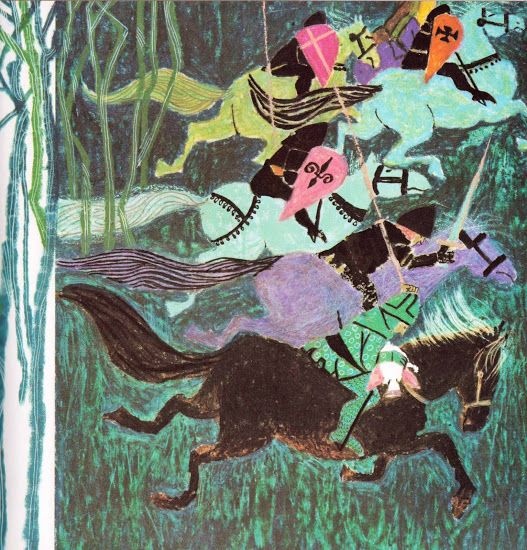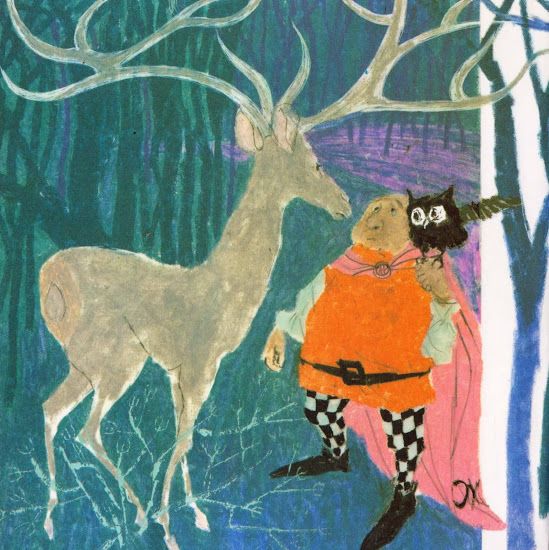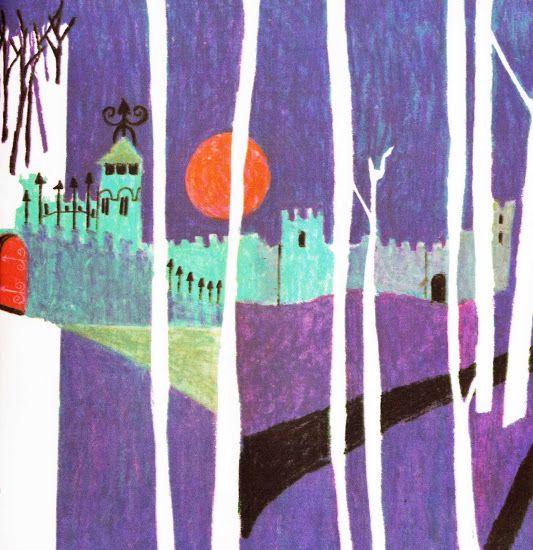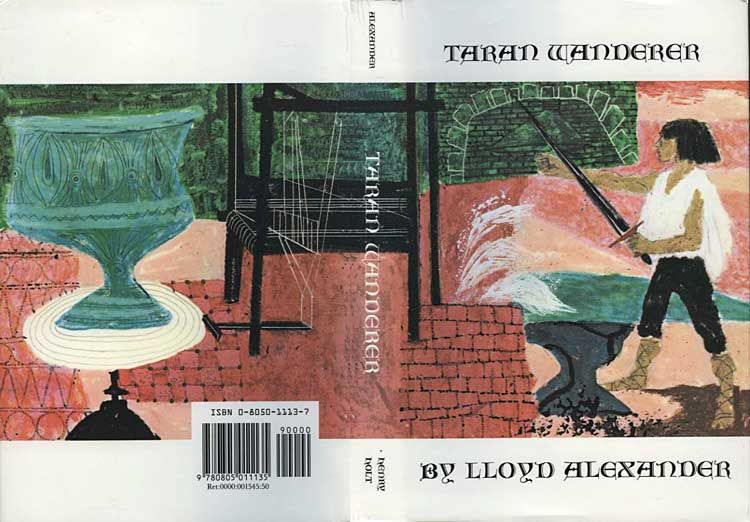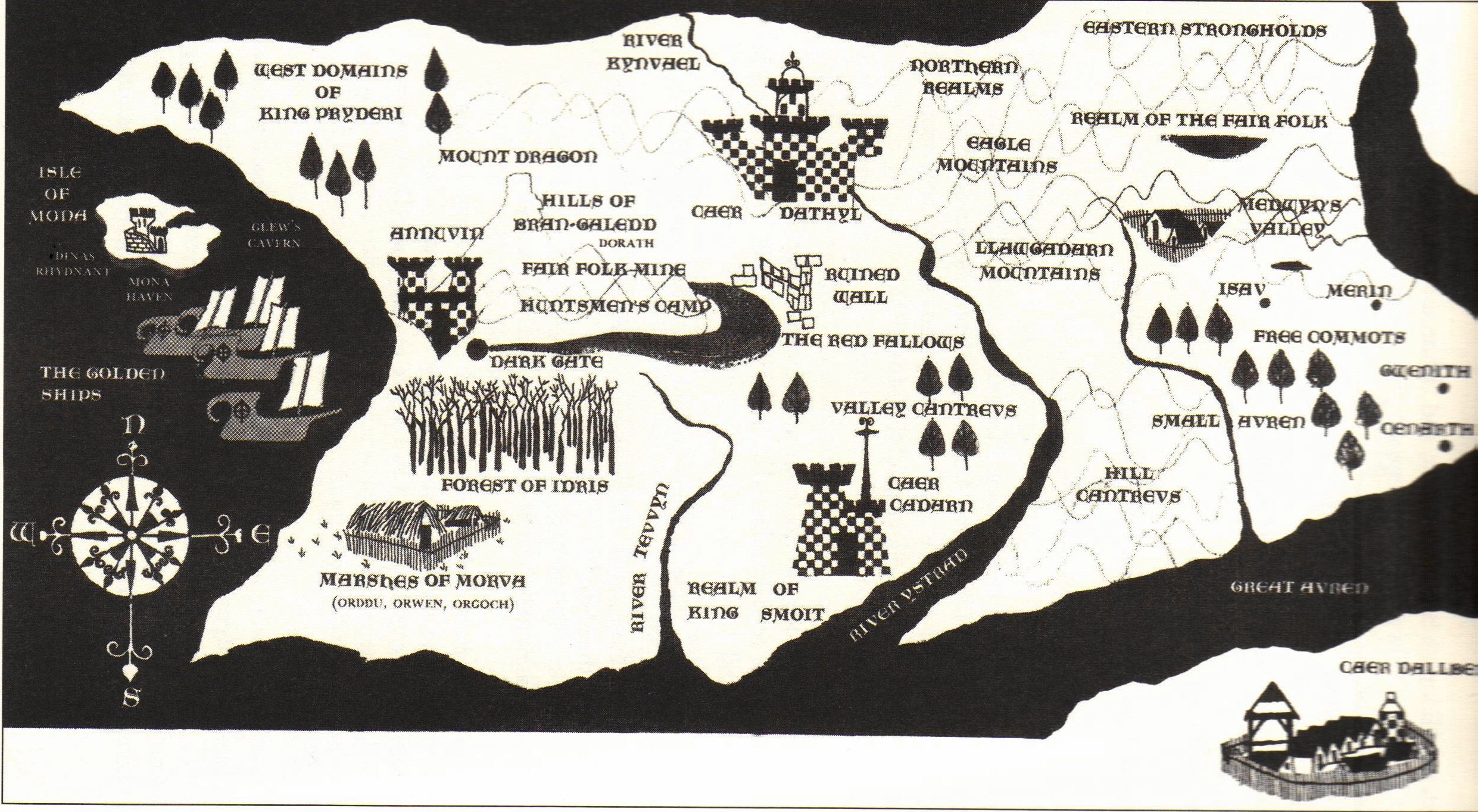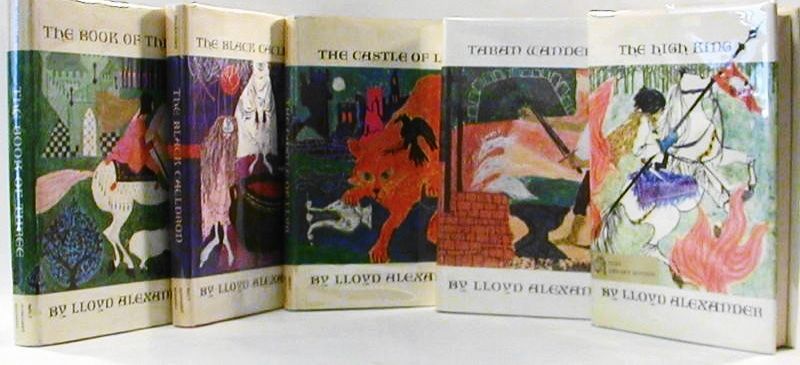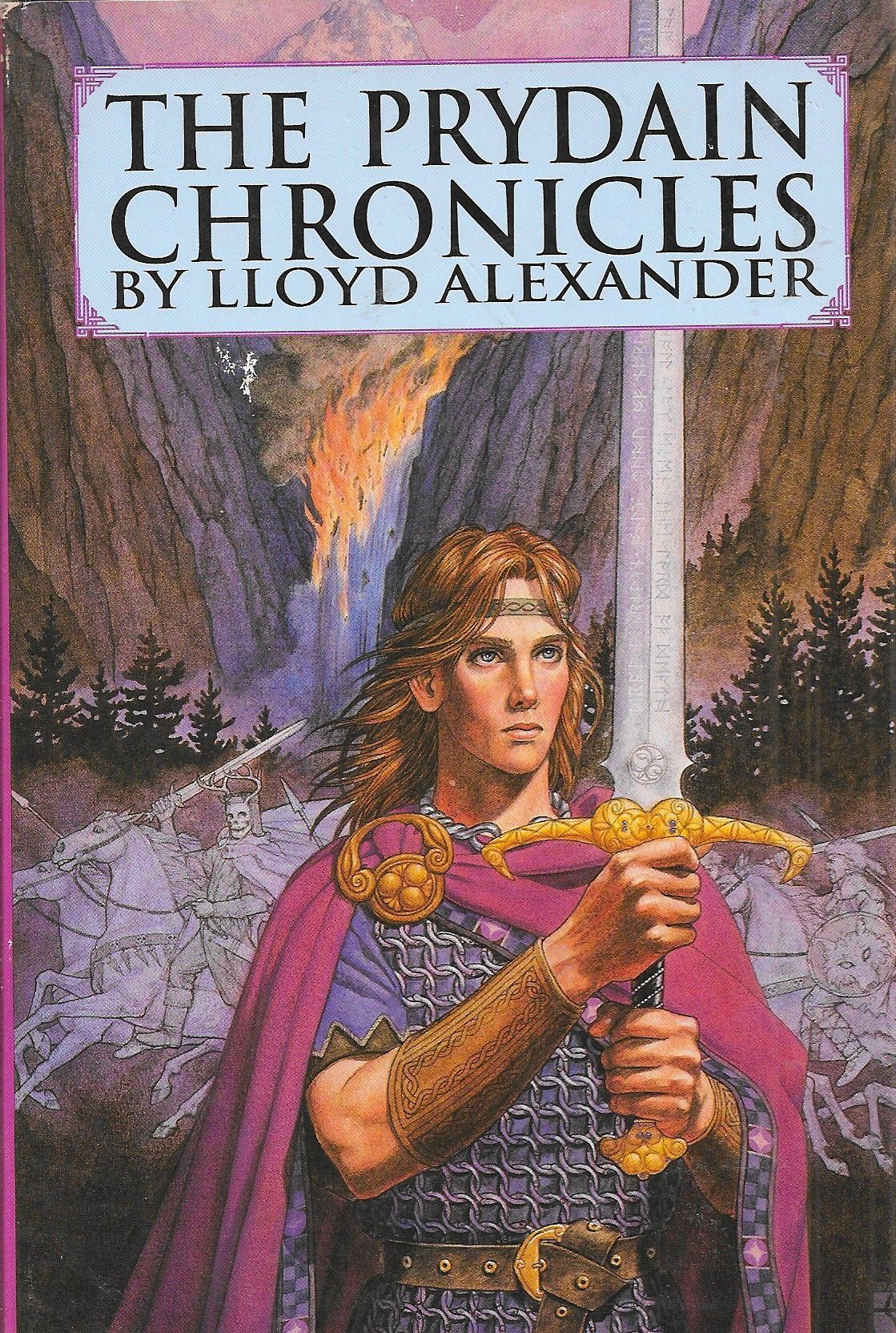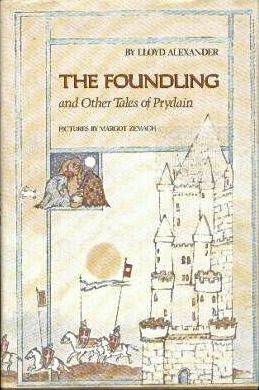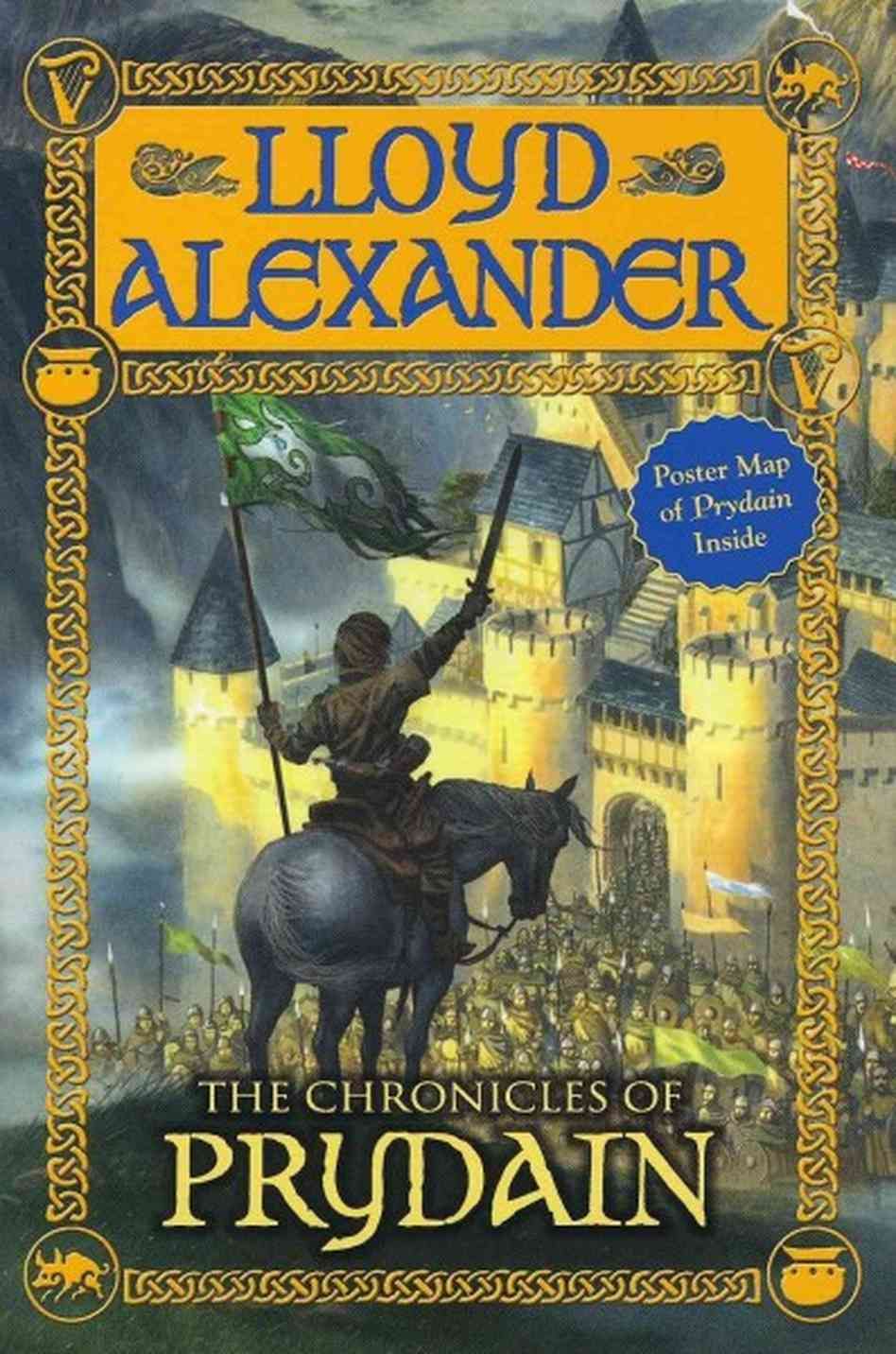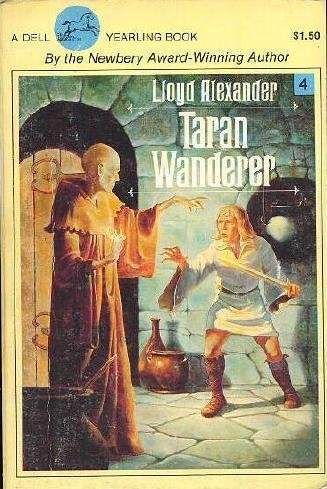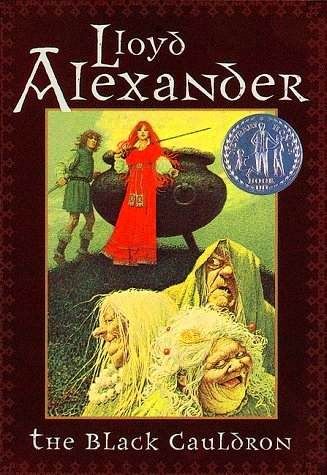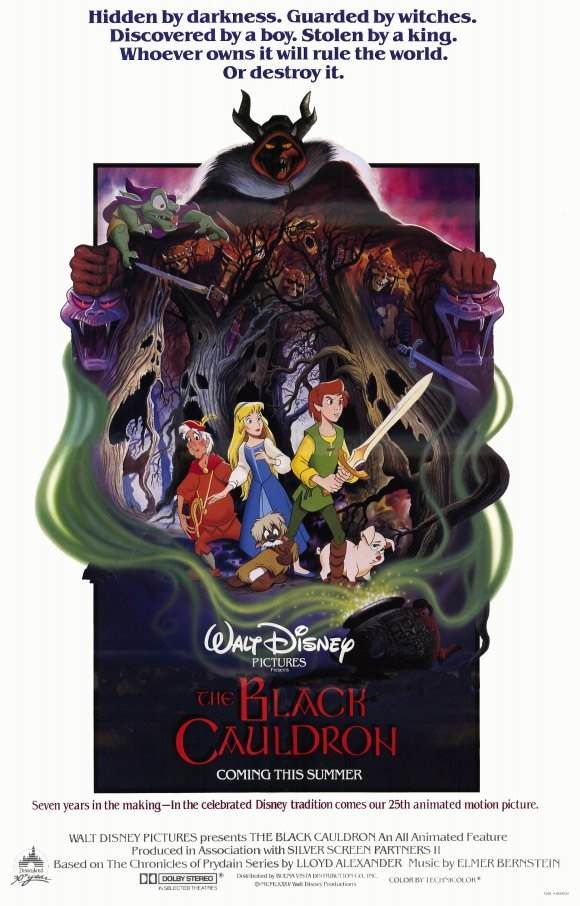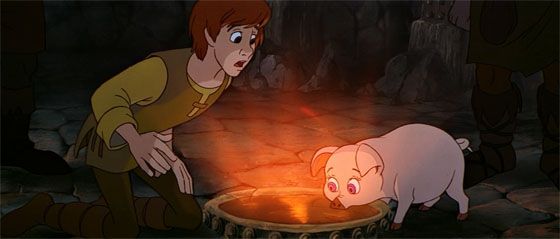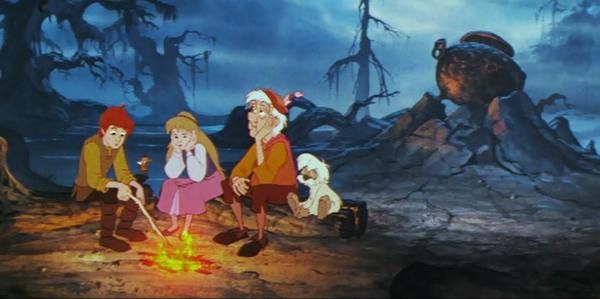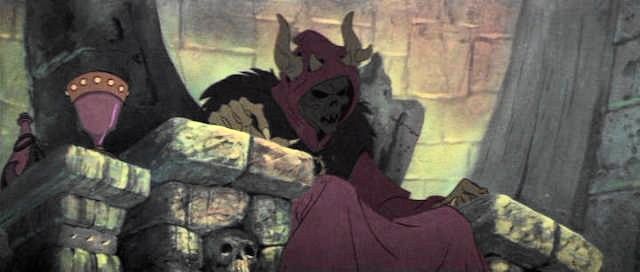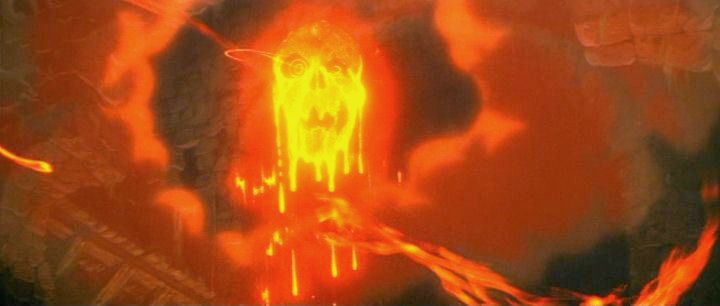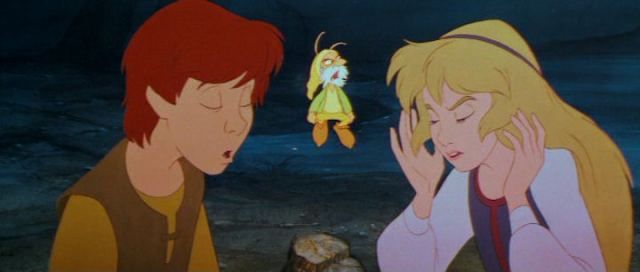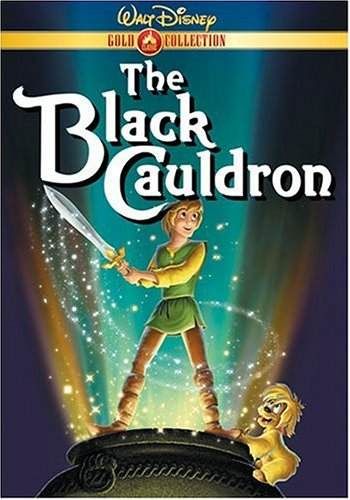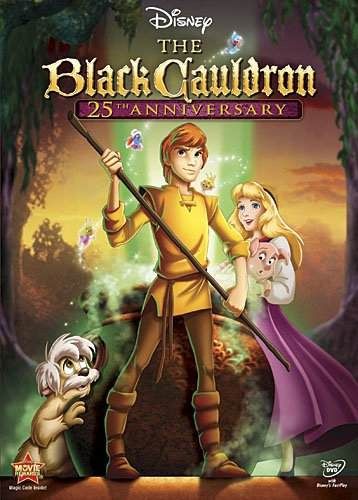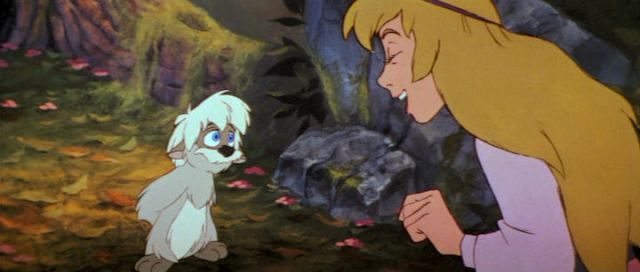No, not that big movie that's out this week. I'm talking about that OTHER series about an orphaned farm boy who longs for adventure, has a gentle aged mentor wise in the ways of magic, befriends a princess, a rogue, and a furry sidekick, and ends up doing battle with an evil Emperor and his terrifying masked war lord to save a kingdom.
I am speaking, of course, of Lloyd Alexander's Chronicles of Prydain.
I first encountered the land of Prydain when I was very young. Right around the time I'd read all of the Narnia books, which I'm guessing would have been when I was nine or ten. Second or third grade... no later than the fourth grade, for sure. Mrs. Lapidus, the youth librarian in the Oswego branch library that was always ready with a recommendation, suggested I might like this one.
This was the tale of how Coll the farmer had his magical pig, Hen Wen, stolen by Arawn Death-Lord, and how he journeyed to the evil land of Annuvin to get her back.
It was illustrated by Evaline Ness, and it was her jagged, impressionistic version of Prydain that imprinted on me.
Coll and His White Pig was a small children's picture book, really almost too easy a read for me then-- "a little kid's book," was how I was inclined to dismiss it-- but it was a great setup for the main novels in the series. Those were also illustrated by Evaline Ness. Just the front covers and the maps in the frontispiece, but that was enough.
When I moved on to the novels, I started with Taran Wanderer, and it's still my favorite. Though there is a clear sequence, and each book builds on the one before it, I kind of bounced around depending on what was in the library at the time. The important thing was that I read The High King last, because it has most all of the big reveals to the various ongoing mysteries and resolves almost all of the various ongoing character arcs. It is a hugely satisfying conclusion to an epic saga and won the Newbery Award that year.
I have an occasional itch to own the books in the original hardcover, but that is so far out of our price range it's ridiculous. A full set of Prydain Chronicles hardcovers in the first edition will run you thousands of dollars -- last time I looked a set was going for somewhere around $2300, with an additional $300 or so for Coll and His White Pig. Even my omnibus hardcover edition that incorporates all five novels and most of the pieces from The Foundling (a book collecting the various Prydain short stories) has jumped up to thirty or forty dollars.
But that's just me being an antiquarian bookscouting nerd. The novels themselves are readily available in various editions, they've never been out of print. A few minutes on Amazon and you could probably score a nice set for twenty or thirty bucks. If you don't mind ex-library hardcovers with stickers and stamps, it'll run you considerably less than that, probably.
It remains, I think, my favorite of all the various sword-and-sorcery book series I've read over the years; certainly, it was the Prydain novels that gave me a taste for the stuff. Without Lloyd Alexander's Prydain back in elementary school, I'd probably never have bothered with Fritz Leiber or Robert E. Howard or J.R.R. Tolkien or any of the legions of others, in both comics and prose. I still think Alexander's better than Tolkien, for that matter. (But then again I'm the heretic who thinks Tolkien should have quit after The Hobbit, so your mileage may vary.)
So what's the Prydain saga about? Well, it has its roots in Welsh mythology-- in the same way T.H. White used Arthurian legend to construct The Once and Future King, Alexander uses the legends of Wales as a jumping-off place to create his own thing.
The five novels taken together comprise the coming-of-age story of young Taran, who is introduced to us in The Book of Three as a teenage orphan boy, the ward of the kindly old wizard Dallben. The homestead of Caer Dallben is run by Coll the farmer, whose chief duties are tending the garden and seeing to the livestock, particularly Hen Wen, the magic pig. Taran's primary responsibility is helping Coll with the farm, but it chafes him; much like Luke Skywalker would a decade later, Taran dreams of being a hero and going off to fight glorious battles in a righteous cause. Coll snorts at this, and says there's just as much honor in being a farmer as being a warrior, he's done both-- and no sane man dreams of fighting in a war. If Taran wants a title, why, he can call himself an Assistant Pig-Keeper. Shortly thereafter, Hen Wen escapes and Taran follows. In the course of chasing his lost pig, he runs across Prince Gwydion, on his way to consult with Dallben-- and Dallben's oracular pig, Hen Wen. Gwydion is trying to find out more about the fact that Arawn Death-Lord's war chief, the Horned King, is raising an army against Gwydion and the Sons of Don. Taran and Gwydion then set off after Hen Wen, only to be captured by the evil witch Achren. In the course of the adventure Taran is separated from Gwydion, escaping from Achren to find himself leading a motley band of Achren's other escaped captives. The company includes the Princess Eilonwy, a wandering bard named Fflewdur Fflam who's given to exaggeration, a hairy beast named Gurgi whose ugly looks hide a good heart, and eventually also a crabby dwarf named Doli. Together they are desperately trying to stay ahead of the Horned King's evil army and get to Gwydion's home in Caer Dathyl to warn them of what Arawn Death-Lord and the Horned King are planning. And so on. It's a great ride and sets the tone for what follows.
The Black Cauldron, the second book in the series, is even better; Taran is a bit more seasoned now, and has come to understand a little of what Coll was trying to tell him about how battle is not fun and in fact something to be avoided. This book builds on that theme, as the companions are reunited when Prince Gwydion gathers a host of warriors to invade the Death-Lord's evil kingdom of Annuvin to destroy his deadliest weapon-- the Black Cauldron, a great big iron vat that, when you dump a corpse into it, will revive that corpse into a mindless warrior slave that can't be killed. Arawn's army of "deathless Cauldron Born" are pretty much impossible to defeat, their only weakness is that they can't travel too far from Annuvin. But Gwydion reasons that if they destroy the cauldron, Arawn can't make any MORE zombies, at least. As before, Taran and his posse are separated from the rest, stumble across the Cauldron themselves, and find out that the only way to destroy it is for a live person to climb into it. That will shatter the evil thing, but the catch is that action also kills the guy that climbs in. Moreover, it only works as a knowing sacrifice, so there's no question of tricking someone into doing it. This book is an amazing tour de force about fake heroism and real sacrifice and doing the right thing no matter what it costs you; themes Alexander returns to again and again, and it's something Taran learns a lot about over the course of the series. The Black Cauldron was another Newbery honoree.
The Castle of Llyr is probably the weakest of the books, but still great fun. This is the story of Eilonwy leaving Caer Dallben to go learn how to be a real princess on the Isle of Mona from kindly King Rhuddlum and Queen Teleria; a sort of finishing-school experience that neither Eilonwy nor Taran are happy about. Eilonwy would much rather be out riding and having adventures, and Taran is slowly realizing that he loves Eilonwy and won't have a chance with her if she has to go be a princess. Before any of this is resolved, Achren the witch, back for more mischief, kidnaps Eilonwy and it's up to Taran and Gurgi to find her before Achren uses Eilonwy's latent enchantress powers to do all sorts of evil magic stuff.
Taran Wanderer is the story of Taran journeying all over Prydain to try to find his true parents-- he's obsessed with the idea that he can't ask Eilonwy to marry him unless he knows who he is (and he's hoping that his lineage is at least noble enough to give him a shot with the Princess.) Instead, he learns how to be a man, and how who that man is depends not on his ancestry but on the choices he makes. Along the way, he meets kings and wizards and old friends and new foes.... I am so not doing it justice. But I adored this book when I was ten and still do today. More than any of the others, reading it felt enormously personal to me; let's just say the idea of constantly failing your own unrealistic expectations and learning how to value yourself in real terms was a message that resonated hugely with a kid that loved books and reading and was constantly vilified for it by schoolyard bullies and uncomprehending teachers and parents. But apart from that I just like it the best. And it's a beautiful set-up for the final book in the series...
...The High King, which opens with Taran and Gurgi returning from their wanderings to a resounding welcome at Caer Dallben, including Eilonwy, who's had quite enough of the 'gossipy hens' at Queen Teleria's court... but then Fflewdur and Gwydion, both wounded, stagger into the farm with terrifying news-- Arawn Death-Lord now has the magical sword Dyrnwyn, and with it can conquer all Prydain. Worse, the losses incurred in the earlier books-- the end of the Horned King and the destruction of the Black Cauldron-- have made Arawn desperate. This is the final push, the all-or-nothing battle for all of Prydain. And as I said earlier, it is epic in scale and tremendously satisfying to everyone who'd hung in there for the course of the series. The reason I am so adamant about not starting with it, even though all five novels are self-contained (there are a lot of writers who could learn from Lloyd Alexander about constructing new-reader-friendly installments in a series) is that you miss out on the fun of seeing things so beautifully concluded with characters you're already invested in. (I tend to think of Taran Wanderer and The High King as parts one and two of a big finale, but that's me.)
Anyway. As fantasy series novels go The Prydain Chronicles are widely acclaimed and beloved by kids and adults all over the world. You'd think it'd be a natural for movies or TV.
Certainly Disney thought so. How this beloved book series morphed into one of the most famous disasters in Hollywood history is a slow-motion trainwreck that unfolded over a decade.
The studio optioned the books in 1971 with the idea that it was the first step in a return to greatness. You may recall that in the early seventies, Disney had gotten away from the famous fairy-tale animation films like Snow White and Bambi that had made the studio such a powerhouse, and was instead getting a rep for churning out an endless chain of lame family comedies like Herbie Rides Again, The World's Greatest Athlete, and That Darn Cat. Animated efforts tended to be musical comedy films like Robin Hood or weird hybrids like Bedknobs and Broomsticks. The Disney brand was synonymous with unthreatening, bland movies that even kids didn't take seriously any more. The contrast was especially apparent when the older stuff was getting aired weekly on television as episodes of The Wonderful World of Disney; stacked up next to the classics so readily available on TV, movies like The Apple Dumpling Gang were just embarrassing. Conventional wisdom was that chances of any further good stuff from Disney in the classic tradition was as dead as Walt himself.
So Prydain was seen as a chance to reclaim the status that the animation studio had lost. Lots of animators were lured to the studio to work on the project, including a young John Lasseter. But nobody really understood how to make it go. Disney animators had always worked as a sort of loose assembly line, using a relatively simple story as a frame to hang various individual set pieces on. But the Prydain books were much more complex, and there were character arcs and plotlines that had to stay consistent throughout; this mosaic approach wouldn't work. Moreover, there was no thought of doing the series as a series-- it sounds crazy today, but back in the seventies, nobody was doing sequels, and certainly not Disney animation. The brand they were hoping to ignite was DISNEY, not Prydain.
There was difficulty in figuring out a coherent script as well. But finally they settled on a screenplay for The Black Cauldron, which was a mashup of the first two novels. In 1977, the studio's interest was re-energized by the Star Wars phenomenon, and actual work began on The Black Cauldron.
All the beloved characters are there-- Taran, Eilonwy, Fflewdur, Gurgi, and so on-- but they've all been designed with the classic Disney kid's look. This was counter-intuitive to the studio's hopes to do something geared more towards a teenage audience, something that would appeal to the newly-minted fantasy fans wanting more stuff like Star Wars. And Prydain, for the most part, is much more of a dark fantasy-- much like Disney's own Bambi or Old Yeller, the books usually start cute and get grim. Characters are hurt and some die.
But then other studio types worried that they were getting too far away from the Disney tradition and the safe bet would be to do something in the classic kid's cartoon tradition. And this ongoing, constant push-pull on the approach was deadly. Disney's Black Cauldron was so cute in its design, and so schizophrenic about what kind of story it wanted to tell, that there are huge needle-scratch What the hell? moments whenever the story turns dark. When the Horned King and the Cauldron-Born show up, it's like they're being imported from some other movie.
The animation studio took a huge hit when Don Bluth left, and took the best of the Disney animation crew with him, to go make The Secret of NIMH. Still, the project trudged on with the younger, less-senior animators. It took seven years until Disney finally had a cut of the film finished in 1985. Test audiences, were, for the most part, horrified. Kids were scared and parents were angry.
Disney execs were horrified as well. The release of the film was pushed back six months. At the same time, regime change was happening at the studio. Michael Eisner and Jeffrey Katzenberg had just taken over the reins and they both hated the film. Katzenberg, famously (or infamously) was so angry at the final product that he charged into the editing room and started making cuts himself.
Eisner went in afterward and restrained him from doing any more, but Katzenberg insisted that twelve minutes be cut. The resultant patchwork is what slunk into theaters and proceeded to become the first Disney animated feature to lose money. It sank like a stone.
To this day Disney would prefer to forget it. It's on DVD but not Blu-ray. I am as baffled as anyone as to why there was a "25th anniversary" DVD reissue edition, but there's not much on it: one deleted scene but not the entirety of the missing 12 minutes.
The film has a small cult following but nobody argues that it's good. The best anyone will admit to is that it's okay, or that it's not as bad as people say it is. Lloyd Alexander himself was gracious: "First, I have to say, there is no resemblance between the movie and the book. Having said that, the movie in itself, purely as a movie, I found to be very enjoyable. I had fun watching it. What I would hope is that anyone who sees the movie would certainly enjoy it, but I'd also hope that they'd actually read the book. The book is quite different. It's a very powerful, very moving story, and I think people would find a lot more depth in the book." Trust me when I tell you that this is a vast understatement.
All that being said... I have to admit that I'm in the not-as-bad-as-people-say camp. There are no annoying musical-comedy interludes, and really the film's greatest weakness is that push-pull I mentioned earlier. It's a teen film disguised as a little kid's film, and the cuts left viewers with a slightly incoherent story. It's... okay. Bookish kids like I was who are into fantasy stories probably would like it well enough, and it serves well enough as an introduction to the novels: you can still sort of see Alexander's books underneath it all, but whether that saves it for you or enrages you is dependent on what kind of fan you are, I guess.
What enrages me about Disney's Cauldron isn't so much the Frankenstein patchwork it became but rather the missed opportunity it continues to represent. In a world where the Harry Potter and Hunger Games films are so huge, and Shannara from Terry Brooks is about to become a high-end TV project, Prydain seems like an obvious starting place for a crew of smart filmmakers to create another mega-hit fantasy film series. Unfortunately, Disney still owns the movie rights to Prydain. But even if it didn't, no studio is going to touch a property so synonymous with disaster. You might as well try and shop a proposal for a sequel to Ishtar or Heaven's Gate.
The ironic part is that Disney did eventually get it right-- with Narnia. Their production for the first two film adaptations of the Narnia books is exactly what I want from that kind of thing: adapt the books to the best of your ability, streamline the story but don't throw away the important stuff, find what people liked about the originals and do THAT. And they're live-action, which is really what Prydain should be.
I live in hope that some day someone in a position to make big-budget movies will figure it out. But it's not likely as long as Prydain is synonymous with one of Disney's biggest flops.
Nevertheless, the 1985 movie's worth a look-- and the books have my strongest recommendation, especially now that they're available in one omnibus edition. Chances are, though, that you'll end up as wistful about the missed opportunity the animated Cauldron was as I am.
See you next week.

